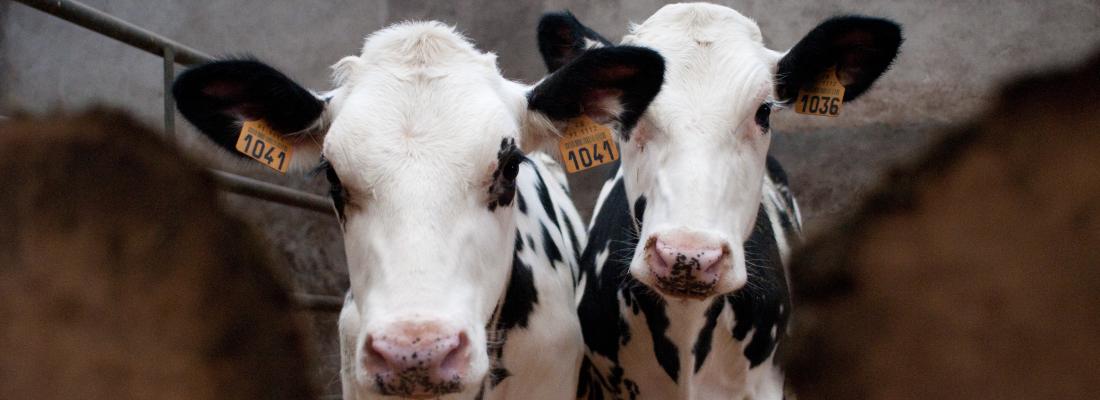Food, Global Health Reading time 5 min
Towards a new vaccine solution for bovine respiratory syncytial virus
Published on 31 July 2019

Bovine Respiratory Syncytial virus, or BRSV, is a major pathogenic agent that causes respiratory diseases in cattle, particularly when they are young. The vaccines available until now offered only partial protection. In the context of the European SAPHIR consortium, several candidate vaccines against BRSV were tested in calves whose specific immunological features linked to their young age represented an obstacle to the efficacy of conventional vaccines. One of the major problems is to be able to effectively vaccinate calves carrying interfering antibodies from their mothers. The results were the fruit of collaboration between INRA, the Pirbright Institute (UK), the Swedish University of Agricultural Sciences (Sweden), the PME Ingenasa (Spain) and the NIH (USA).
Better protection than vaccines currently on the market
Several vaccine strategies were tested during the SAPHIR project. Some achieved remarkable performances, better than those procured by any vaccines currently available on the market. Amongst these successful candidates, it was a solution using a recombinant protein from BRSV, called pre-F (for pre-fusion protein), which notably attracted the attention of the scientists. This candidate vaccine was effective in a single dose. It demonstrated the best clinical protection (fewer clinical signs and fewer pulmonary lesions observed after an experimental infection in animals vaccinated using pre-F) and virological protection (little or no virus detected in the upper or lower airways of animals vaccinated with pre-F following an experimental infection). The candidate vaccine also displayed excellent safety and could be administered simply via the intramuscular route using a standard veterinary adjuvant employed in bovine vaccines. The pre-F vaccine was able to induce more specific immunoglobulins (including neutralising antibodies) and interferon-producing cells (IFN γ) than the other strategies studied.
A single-dose vaccine associated with a DIVA test
Effective with a single injection, the pre-F candidate appears to be the optimum solution for the development of a commercial vaccine against BRSV. In addition, using just a specific protein fraction from the BRS virus, a companion DIVA test (Differentiating Infected from Vaccinated Animals) was also developed during this project. This test, based on an INRA patent, will facilitate control of the infection in livestock units.
SAPHIR, a project that aims to control endemic animal infectious diseases through vaccination
The SAPHIR project reached its term in February 2019. This major project was distinctive for the original combination of scientific disciplines involved (immunology, infectious diseases, genetic engineering, genomics and genetics, mathematical modelling, economic and social sciences) and for its integrated approach to the control of animal infectious diseases through the implementation of vaccine strategies.
Targeting the pathogenic agents responsible for major economic losses in the cattle, pig and poultry sectors, SAPHIR’s objective was to develop novel vaccine approaches by contributing new scientific knowledge (immunocompetence mechanisms at different ages, biomarkers and correlates for the protection induced by vaccines, use of “systems-vaccinology" strategies), and by evaluating new candidate vaccines that could control mutants of constantly emerging pathogens (antigens conserved between strains, parasitic, bacterial and viral recombinants, DNA vaccines, new adjuvants).
Perspectives for the application of SAPHIR vaccines were considered using the mathematical modelling of vaccination under field conditions, evaluating parameters for the industrial development of vaccines and analysing the socioeconomic parameters that would govern use of the vaccines developed in the context of SAPHIR (perceptions of livestock farmers, ease of use, cost-benefits and the specificities of different sectors).
- 11 European countries represented, plus the participation of China
- 14 academic partners, 19 laboratories
- 6 companies, including 5 SME.
- JRU Molecular Virology and Immunology INRAE, Univ. Saint Quentin en Yvelines), Île-de-France - Jouy-en Josas-Antony
- JRU Animal Genetics and Integrative Biology (INRAE, AGROPARISTECH), Île-de-France - Jouy-en Josas-Antony
- JRU Pathogen/Host interactions (INRAE, ENVT), Occitanie-Toulouse
- Experimental Infectiology Platform, Val-de-Loire
Budget: €10.7M, funded by the European Commission (€9 M) and the Swiss Federal Government.
- Brevet WO/2006/117456 Preparation of soluble N-protein/truncated P-protein complexes or N-proteins soluble in a virus of the paramyxoviridae family and use thereof in vaccines.
- Hägglund et al. (2017). Proteome analysis of bronchoalveolar lavage from calves infected with bovine respiratory syncytial virus—Insights in pathogenesis and perspectives for new treatments. PLoSONE 12(10): e0186594. https://doi.org/10.1371/journal.pone.0186594
